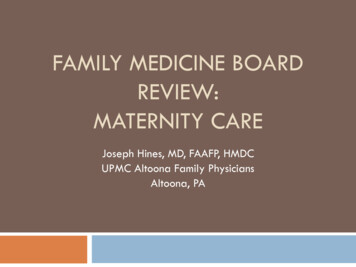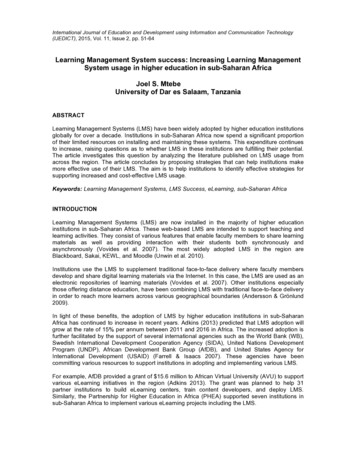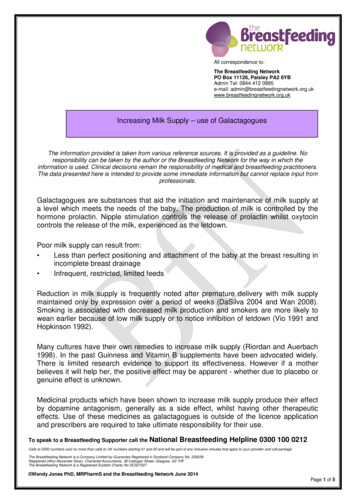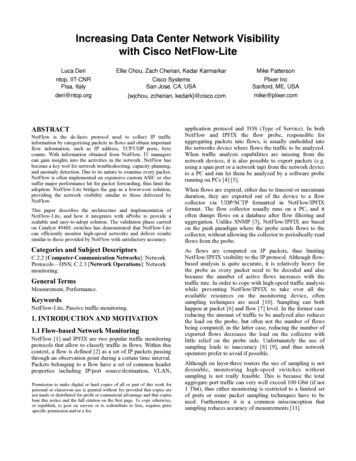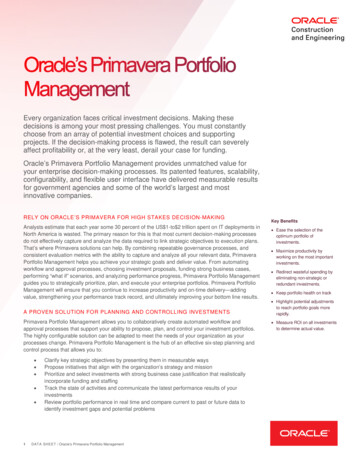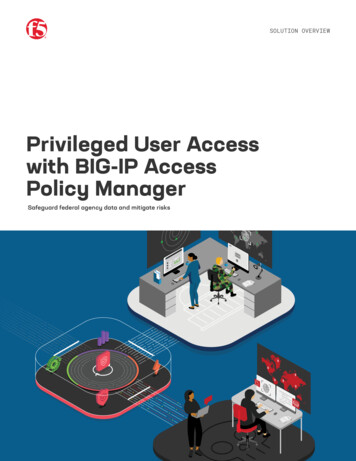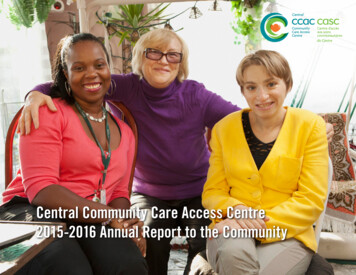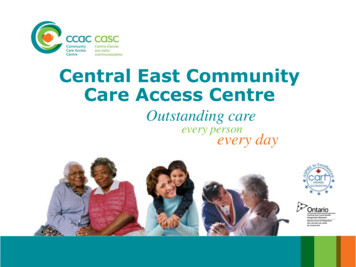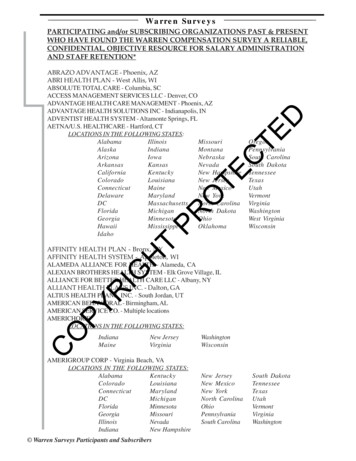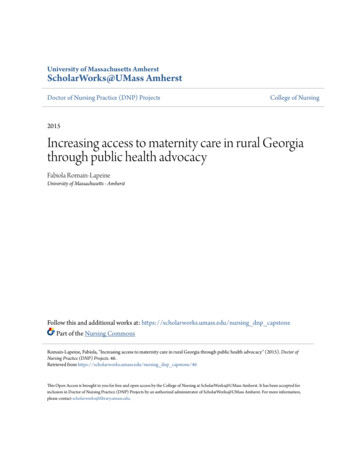
Transcription
University of Massachusetts AmherstScholarWorks@UMass AmherstDoctor of Nursing Practice (DNP) ProjectsCollege of Nursing2015Increasing access to maternity care in rural Georgiathrough public health advocacyFabiola Romain-LapeineUniversity of Massachusetts - AmherstFollow this and additional works at: https://scholarworks.umass.edu/nursing dnp capstonePart of the Nursing CommonsRomain-Lapeine, Fabiola, "Increasing access to maternity care in rural Georgia through public health advocacy" (2015). Doctor ofNursing Practice (DNP) Projects. 46.Retrieved from https://scholarworks.umass.edu/nursing dnp capstone/46This Open Access is brought to you for free and open access by the College of Nursing at ScholarWorks@UMass Amherst. It has been accepted forinclusion in Doctor of Nursing Practice (DNP) Projects by an authorized administrator of ScholarWorks@UMass Amherst. For more information,please contact scholarworks@library.umass.edu.
Increasing Access to Maternity Care in Rural Georgia through Public Health AdvocacyByFabiola Romain-LapeineSubmitted to the Graduate School of theUniversity of Massachusetts Amherst in partial fulfillmentof the requirements of the degree ofDoctor of Nursing PracticeMay, 2015College of NursingApproved as to style and content by:Dr. Pamela Aselton: College of Nursing Committee ChairDr. Raeann G. LeBlanc: College of Nursing Member
PUBLIC HEALTH ADVOCACY2AcknowledgmentsThe author would like to acknowledge the support of Dr. Raeann G. LeBlanc & Dr.Pamela Aselton for critiquing this manuscript and providing support and guidance throughoutthis project and process.
PUBLIC HEALTH ADVOCACY3AbstractGeorgia has the second highest maternal mortality rate and eighth highest infant mortality rate inthe country. Regardless of location, race, socioeconomic class or education level, access toquality maternity care will significantly improve the outcomes for both mother and baby. In2012, the maternal mortality rate in rural Georgia was 24.3% compared to 16.5% in non-ruralGeorgia. Increasing the use of well-trained Certified Nurse Midwives (CNMs) is essential to theprovision of high-quality rural maternity care throughout pregnancy, birth and the postpartumperiod. Including CNMs as preceptors in the Georgia Preceptor Tax Incentive Program (GAPTIP) policy can increase the quantity of midwives who will practice in the rural areas. Nursesneed education in the role of advocate in order to change policies and systems that effect thepopulation they are caring for. The purpose of this project was to implement a public healtheducation intervention with nurses and nursing students on how to address increasing access toquality maternity care in rural Georgia through public health advocacy as an initial phase inaddressing this problem of healthcare access.Keywords: health policy, nursing practice, Nursing education, Health care policy, legislativearena, legislative process, nurse advocacy, policy advocates, politics, policy process, healthpolicy
PUBLIC HEALTH ADVOCACY4Table of ContentsIntroduction .1Hypothesis . . .13Methods . .14Results 21Recommendations .25Conclusion . .26References . .28Appendices . .34
PUBLIC HEALTH ADVOCACY1Increasing Access to Maternity Care in Rural Georgia through Public Health AdvocacyIntroductionMaternal death and complications are a problem both in the United States and around theworld. Globally, the rate of women dying due to childbirth has decreased by 2.6% per year since1990; however, as of 2013 approximately 800 women continue to die each day from preventablecauses related to pregnancy and childbirth (World Health Organization [WHO], 2014a). TheUnited States (U.S.) places 47th in the world for maternal mortality, which is higher than almostall European countries, as well as several countries in Asia and the Middle East. (Coeytaux,Bingham, & Strauss, 2011).The problems of maternal mortality can be prevented by using an upstream approach ofincreasing quality access to maternity care from the beginning of pregnancy. The United StatesDepartment of Health and Human Services (DHHS), Healthy People 2020 (2011) states the riskof maternal and infant mortality in addition to pregnancy-related complications can be reducedby increasing access to quality preconception (before pregnancy) and inter-conception (betweenpregnancies) care. These issues are significantly plaguing rural areas of the U.S. due to a lack ofqualified maternal care providers including certified midwives and obstetricians.Nurses can address this issue through advocacy. Advocacy is defined as “Pleadingsomeone’s cause or act on someone’s behalf, with a focus on developing the community, system,individual or family’s capacity (Minnesota Department of Health [MDH], 2001). Nurses canspeak knowledgeably about what patients and communities need because they experience it firsthand (Mason, Leavitt & Chaffee, 2007, p. 35). They also possess skills which can be used in thepolitical arena that are learned though their education and further refined in clinical practice suchas communication, persuasion, education, critical thinking, analysis, collaboration and advocacy
PUBLIC HEALTH ADVOCACY2(Mason et al., 2007). Nurses are able to contribute significant information and wisdom on avariety of issues, initiatives, policies, etc. They can make an impact and encourage systemicchange by incorporating public health advocacy into their practice through the various levels ofactivity in the roles of nurse citizen, nurse activist and nurse politician.Problem StatementThere is a lack of accessible care for pregnant women in rural Georgia outside ofmetropolitan Atlanta. It has been estimated that there is currently a 52% deficiency of maternalcare providers for women of childbearing age in rural Georgia and by 2020 it is projected toincrease to 75% if successful interventions are not implemented (Zetuche & Spelke, 2013) (SeeAppendix A for map of projection). This is caused by the inadequate recruitment and retention ofrural obstetric providers and increasing maternity unit closures in rural hospitals (Zetuche &Spelke, 2013). According to Zetuche & Spelke, Georgia OB/GYNs providers discontinueobstetrical care due to a variety of issues including:1) Demanding call schedules related to departure of other local obstetricians2) Unfavorable legal environment related to quash of the malpractice compensation capas well as a restrictive political climate3) Low reimbursement rates since 50-60% of Georgia births are Medicaid-funded andpays approximately 1,300 for pre- and perinatal care which is 50-60% the privatereimbursement rate (2012). Low Medicaid reimbursement, hospital closures, inadequateinter-professional collaboration & state laws are also part of the problem.Nurses are not generally prepared to engage in any level of activity in policy work, and tend tofocus on individual patient advocacy rather than population based initiatives. It has been
PUBLIC HEALTH ADVOCACY3suggested that the reason some nurses are indifferent about policy issues may be due to a lack ofknowledge and preparation to assume these roles as well as understanding that their influencecan produce results (O’Brien-Larivee, 2011).Evidence of ProblemBackground. Women who reside in Georgia have difficulty accessing health care mainlydue to deficient access to obstetric providers. There are 1,164,302 women living in rural Georgiaout of the 9,992,167 people who live in the entire state (Online Analytical Statistical InformationSystem [OASIS], 2014; United States Department of Agriculture Economic Research Service[USDA ERS], 2014). See Appendix F for the population distribution of Georgia. There are375,429 women between the childbearing ages of 15-49 who reside in rural areas (OASIS,2014).Women who reside in Georgia have difficulty accessing health care mainly due todeficient access to obstetric providers. There are currently 148 hospitals in Georgia, 67 of whichare located in rural counties (Rural Assistance Center [RAC], 2014). Hospitals and many of thematernity units in the rural areas are closing at a fast rate due to insufficient funding and staffing.There is only one OB/GYN per 7,125 women in the state (Chu & Posner, 2013). Thosewomen residing in rural areas are more likely to be poor, travel longer distances to receive care,and inadequate medical insurance. (American College of Obstetricians and Gynecologists[ACOG], 2014). For those women who can access the providers, 35% of them do not haveinsurance and the rest either have inadequate health insurance or rely substantially on Medicaidand Medicare (ACOG, 2014; National Women’s Law Center [NWLC], 2010).
PUBLIC HEALTH ADVOCACY4According to the Economic Research Service, the average per-capita income for Georgiaresidents in 2012 was 37,449 much higher than the rural per-capita income which was 29,828,however this figure is highly influenced by the majority of residents who live in the metropolitanAtlanta area (RAC, 2014). The unemployment rate in rural Georgia is 9.5%, while in urbanGeorgia it is 7.9% (USDA-ERS, 2013). As a result the poverty rate is an estimated 24.9% inrural Georgia, compared to 18.0% in urban areas of the state (RAC, 2014). Despite the highpoverty and unemployment rate, the governor opposed expanding Medicaid eligibility to assiststhose who do not earn enough to get subsidized private coverage under the Affordable Care Act.This makes it even more difficult for these individuals to fund their medical needs withoutinsurance.Georgia has the second highest maternal mortality rate and eighth highest infant mortalityrate in the country (Chu & Posner, 2013). In Georgia, over one million women who reside inrural areas are at greater risk for experiencing these deaths due to the lack of maternity careavailable (NWLC, 2010; WHO, 2014b). In 2012, the maternal mortality rate in rural Georgiawas 24.3% compared to 16.5% in non-rural Georgia (OASIS, 2014). Infants of mothers who donot receive prenatal care are three times more likely to have a low birth weight and five timesmore likely to die than those born to mothers who do get care (United States Department ofHealth and Human Services [HHS], Office of Women’s Health, 2012).For infant mortality rates the differences are not as great as the maternal rates with aninfant mortality rate of 7.7% in rural areas compared to 6.6% in non-rural Georgia (OASIS,2014). Women who receive no prenatal care are three to four times more likely to die ofpregnancy-related complications than women who do (Coeytaux, Bingham, & Strauss,2011). Those with high-risk pregnancies are 5.3 times more likely to die if they do not receive
PUBLIC HEALTH ADVOCACY5prenatal care (Coeytaux, Bingham, & Strauss, 2011). These rates demonstrate apparent healthdisparities rural women in Georgia are facing compared to their non-rural counterparts (seeAppendix B for comparisons). Increasing the practice of midwives in rural areas may assist indecreasing these maternal mortality rates.Key to AccessThe key to addressing this issue of accessibility to care in rural areas is to focus onincreasing access to quality maternity providers since it is the major factor that contributes tothese women not receiving obstetric care. Certified Nurse Midwifes (CNMs) are a qualified toaddress this public health issue (MANA, 2014). There are approximately 15,000 practicingmidwives in the United States and they attend approximately 10% of births in the U.S. inmultiple setting such as hospitals, birth centers, and private homes (MANA, 2014).Midwives attended 18.1% of births in Georgia compared to the national average of 8%(NWLC, 2014). In every setting, midwife-led maternity care results in reduced infant andmaternal mortality and morbidity, fewer medical interventions, decreased costs, increasedsavings, and improved client satisfaction (MANA, 2014). As of August 2014, Georgia has 458CNMs, which is the fourth highest number per state in the U.S. (American MidwiferyCertification Board, [AMCB], 2014). However, these CNM’s are significantly concentrated inthe Atlanta metro area (BLS, 2014), and not dispersed into the rural areas (See Appendix C).Barriers to CNM PracticeMidwives face many barriers to practice in rural areas such as insufficient practicum sitesand preceptors, inadequate Medicaid reimbursement, regulatory issues, unsatisfactory intercollaboration with physicians and other healthcare professionals, low pay and continuingeducation opportunities. In the state of Georgia, 50-60% of births are paid by Medicaid which is
PUBLIC HEALTH ADVOCACY6a 37% decline in rates from 2001 to 2011 (Zertuche & Spelke, 2013). Although third-partyreimbursement is not mandated in Georgia, CNMs are reimbursed by Medicaid at 100% of thephysician rate (American College of Nurse Midwives [ANCM], 2014).The Georgia Maternal and Infant Health Research Group (GMIHRG) conducted aqualitative study to outline the challenges facing Georgia’s obstetric system. They surveyedOB/GYNs residents and CNM students in their last year to determine potential influences oncareer choice and job location of these future obstetric providers (Zertuche & Spelke, 2013).They found that financial incentives may be the most effective strategy in recruiting OBproviders in shortage areas. They also found that CNMs are more likely than OB/GYN residentsto seek employment in a shortage area.Financial Incentives to Encourage CNM in Rural AreasThe Health Resources and Services Administration (HRSA) NURSE Corps LoanRepayment Program will pay 60% of registered nurses (including advanced practice registerednurses) unpaid nursing student loans in just two years, and an additional 25% of the originalbalance for an optional third year if they agree to work in a critical shortage area or facilitywhich are usually located in poor urban and rural areas (HRSA, 2014). It is difficult to fulfill thisobligation in rural areas since many of the facilities that are in a critical shortage area or are acritical shortage facility have either closed or shut down the only labor and deliver unit in thecounty. As these institutions close, the providers move away. CNMs need a hospital, or at least abirthing center to practice from in order to improve access to obstetrical care in rural Georgia.The state of Georgia mandates these sites as the only place they are allowed to deliverbabies. Inadequate inter-professional collaboration is a barrier as well. There is a resistance to
PUBLIC HEALTH ADVOCACY7collaboration within the obstetric provider’s field, and it is significantly more apparent in areaswhere there is not currently a strong midwifery presence. An example of this is in Augusta, thesecond largest city in Georgia, where there are only two CNMs in this area. Both CNMs onlywork out of the prenatal clinic, but do not deliver babies. Currently the only physical midwiferyschool in the state is in Atlanta, while medicals schools are only located in four cities; therefore,continuing education is limited in the rural areas. With this shortage, alliance and partnership isnecessary for easy access for guidance, collaboration and even educational opportunities.SolutionBy 2030, Georgia’s female population is expected to increase by 25% (ACOG, 2014).Recruiting and retaining an adequate amount of experienced obstetrics providers to care for thisinflux in rural Georgia is significant in delivering effective services and improving healthoutcomes (WHO, 2012). Increasing the use of well-trained CNMs is essential to the provision ofhigh-quality rural maternity care throughout pregnancy, birth and the postpartum period (Milleret al., 2012). With the lack of providers in the rural areas, inter-professional collaboration and theuse of knowledgeable providers can assist in increasing access promoting good maternal healthin addition to reducing morbidity and mortality rates. In order to do this we need to increasequality CNM student placements in rural areas and support CNM preceptors.Supporting Preceptors to Increase the Accessibility of Care in Rural AreasTraining rural health workers in the rural setting is likely to result in greatly improvedrecruitment and retention of skilled health-care providers in rural underserved areas withconsequent improvement in access to health care for the local communities (Strasser & Neusy,2012). In order to get more healthcare providers into underserved areas, the Georgia Preceptor
PUBLIC HEALTH ADVOCACY8Tax Incentive Program (GA-PTIP) was created in 2014. It is a 10,000 income tax credit forprimary care community based faculty physicians precepting third and fourth year Georgiamedical students, Advanced Practice Registered Nurses (APRN) and Physician Assistants (PA).In this policy the definition of a preceptor is “A licensed Georgia Physician (either MD or DO)providing uncompensated community based training for medical, nurse practitioner, or physicianassistant students matriculating at a Georgia program” (Preceptor tax incentive program, n.d).Midwifery students are unable to find CNM preceptors in the rural and underserved areas where many are interested in practicing upon graduation. The GA-PTIP should bemodified to include APRNS as preceptors in the upcoming 2016 legislative session. Althoughthey both deliver babies, CNMs and OB/GYNs operate under different models and scope,therefore, it would be best for them to be precepted by another CNM. This concept extends toother APRNs. If more APRNS are able to get this credit, then this will lead to providers in therural area precpting students, having assistance in administering care and retention of studentsafter they complete their studies. Increasingly, clinicians and faculty members are motivated toprovide students quality preceptorship placements in rural areas, particularly in light of thepotential for recruitment of new graduates to underserved areas (Yonge, Myrick, & Ferguson,2012). This solution will assist in increasing access to both maternal care and general careproviders in rural Georgia.EvidenceThe terms that were included in the literature search for this review were: “midwives andmaternity and rural”, “midwives and rural”, “incentives and rural maternity care”, “incentivesand rural healthcare”, “incentives and midwifery and rural maternity care”, “Preceptorship &Rural Health Nursing”, “Preceptorship & Rural Health”, “Preceptorship & Rural Health &
PUBLIC HEALTH ADVOCACY9recruit*”, “nurse and health policy”, “public health nursing education and policy”. A total ofeight databases were used to retrieve evidence on CNM’s providing quality maternity care andhow nurses are being educated to incorporate policy and advocacy into their practice: CINHAL,Cochrane Database, PubMed Central, Academic Search Premier, Google Scholar, HealthReference Center Academic, Up-To-Date & Sage.Review of EvidenceHatem, Sandall, Devane, Soltani & Gates (2008) conducted a systematic review of eleventrials (with a total of 12,276 women) to compare midwife-led models of care with other modelsof care for childbearing women and their infants. Substantial benefits for women at low risk ofpregnancy complications who received continuity of midwifery care were noted such as:decreased risk of antenatal hospitalization, use of regional analgesia, episiotomy, instrumentaldelivery, experiencing fetal loss before 24 weeks' gestation and shorter length of stay at hospital(Hatem, 2008).It was also noted that CNM assisted births resulted in an increase in spontaneous vaginaldelivery versus induced vaginal deliveries, breastfeeding initiation and women feeling in controlduring labor and childbirth. The systematic review did not find any differences between groupsfor caesar
inclusion in Doctor of Nursing Practice (DNP) Projects by an authorized administrator of ScholarWorks@UMass Amherst. For more information, please contactscholarworks@library.umass.edu. Romain-Lapeine, Fabiola, "Increasing access to maternity care in rural Georgia through public health advocacy" (2015).Doctor of Nursi
